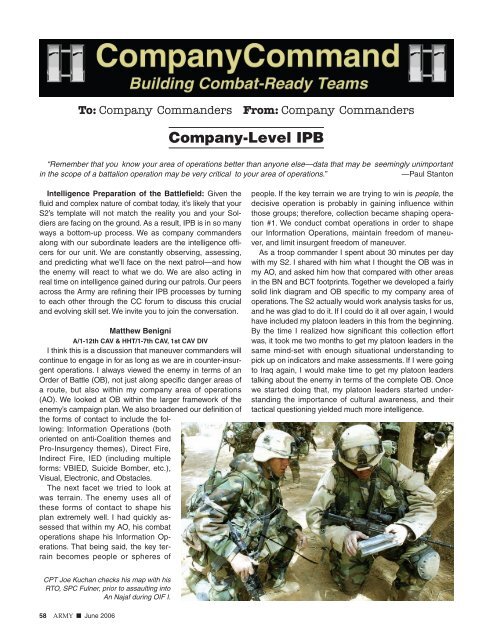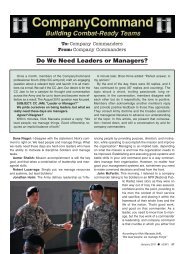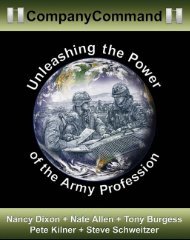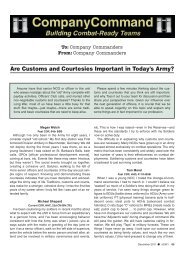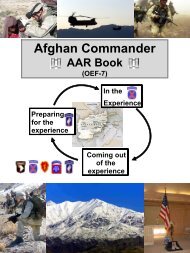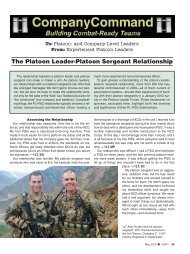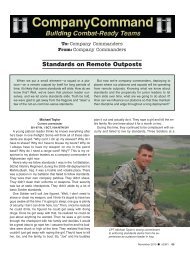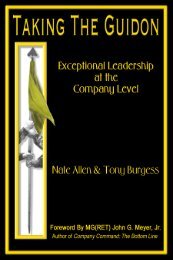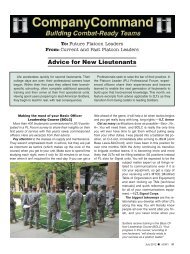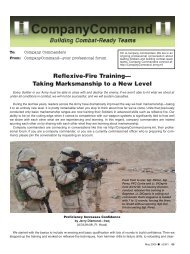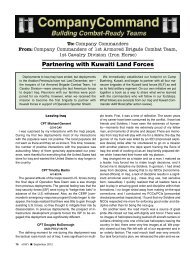Company-Level IPB - Company Command - U.S. Army
Company-Level IPB - Company Command - U.S. Army
Company-Level IPB - Company Command - U.S. Army
You also want an ePaper? Increase the reach of your titles
YUMPU automatically turns print PDFs into web optimized ePapers that Google loves.
To: <strong>Company</strong> <strong>Command</strong>ersFrom: <strong>Company</strong> <strong>Command</strong>ers<strong>Company</strong>-<strong>Level</strong> <strong>IPB</strong>“Remember that you know your area of operations better than anyone else—data that may be seemingly unimportantin the scope of a battalion operation may be very critical to your area of operations.”—Paul StantonIntelligence Preparation of the Battlefield: Given thefluid and complex nature of combat today, it’s likely that yourS2’s template will not match the reality you and your Soldiersare facing on the ground. As a result, <strong>IPB</strong> is in so manyways a bottom-up process. We as company commandersalong with our subordinate leaders are the intelligence officersfor our unit. We are constantly observing, assessing,and predicting what we’ll face on the next patrol—and howthe enemy will react to what we do. We are also acting inreal time on intelligence gained during our patrols. Our peersacross the <strong>Army</strong> are refining their <strong>IPB</strong> processes by turningto each other through the CC forum to discuss this crucialand evolving skill set. We invite you to join the conversation.Matthew BenigniA/1-12th CAV & HHT/1-7th CAV, 1st CAV DIVI think this is a discussion that maneuver commanders willcontinue to engage in for as long as we are in counter-insurgentoperations. I always viewed the enemy in terms of anOrder of Battle (OB), not just along specific danger areas ofa route, but also within my company area of operations(AO). We looked at OB within the larger framework of theenemy’s campaign plan. We also broadened our definition ofthe forms of contact to include the following:Information Operations (bothoriented on anti-Coalition themes andPro-Insurgency themes), Direct Fire,Indirect Fire, IED (including multipleforms: VBIED, Suicide Bomber, etc.),Visual, Electronic, and Obstacles.The next facet we tried to look atwas terrain. The enemy uses all ofthese forms of contact to shape hisplan extremely well. I had quickly assessedthat within my AO, his combatoperations shape his Information Operations.That being said, the key terrainbecomes people or spheres ofpeople. If the key terrain we are trying to win is people, thedecisive operation is probably in gaining influence withinthose groups; therefore, collection became shaping operation#1. We conduct combat operations in order to shapeour Information Operations, maintain freedom of maneuver,and limit insurgent freedom of maneuver.As a troop commander I spent about 30 minutes per daywith my S2. I shared with him what I thought the OB was inmy AO, and asked him how that compared with other areasin the BN and BCT footprints. Together we developed a fairlysolid link diagram and OB specific to my company area ofoperations. The S2 actually would work analysis tasks for us,and he was glad to do it. If I could do it all over again, I wouldhave included my platoon leaders in this from the beginning.By the time I realized how significant this collection effortwas, it took me two months to get my platoon leaders in thesame mind-set with enough situational understanding topick up on indicators and make assessments. If I were goingto Iraq again, I would make time to get my platoon leaderstalking about the enemy in terms of the complete OB. Oncewe started doing that, my platoon leaders started understandingthe importance of cultural awareness, and theirtactical questioning yielded much more intelligence.CPT Joe Kuchan checks his map with hisRTO, SPC Fulner, prior to assaulting intoAn Najaf during OIF I.58 ARMY ■ June 2006
In hindsight, gaining influence ended up being the purposeof my decisive operation, but until I had enough situationalunderstanding within my AO to effectively conducthumanitarian aid and information operations, collectionshould have been my first priority. Early in our campaignwe focused on combat operations as the decisive operations,and it took a significant transition in mind-set to eventuallygain influence in our company area of operations.Paul StantonB/1-502nd IN, 101st ABN DIV (AASLT)From a maneuver CDR’s perspective…keep in mind thatthe “deuce” only knows what you tell him or her and thequality of the analysis will reflect the input. You are the onewho knows what is going on in your AO better than anyoneelse—give the info to the S2. Priority Intelligence Requirements(PIR) are generated based on mission requirements—inthis amorphous environment you have to keepthe S2 informed so that you can adjust as necessary.The S2 is supporting the BN—you have to focus whathe/she gives you for your AO. There may be a tendency toinherit the S2’s <strong>IPB</strong> and go with it—this would be a criticalmistake. As the master of your AO, you MUST refine whatyou get. You are not absolved from answering the intelligencerequirements, but you should not rely on it exclusivelyas you prepare for your own missions/patrols.The S2 has limited people and assets to support him/her.If you overwhelm the S2 with “reports” that have little meaning,it isn’t going to help anyone. I always gave the S2 theraw data, but I put my own analysis as a cover. Rememberthat you know your AO better than anyone else—data thatmay be seemingly unimportant in the scope of a BN operationmay be very critical to your AO. The S2 won’t know itunless you provide it. My experience was that providingmy analytical insight to the S2 (along with all of the raw reports)helped focus the limited assets that the S2 had. Theresult was better input back to me.I talked to the S2 every day, multiple times. I let him knowwhat intel I needed, and helped him wade through the detailsof my patrol activity. Constant communication is a must.Ted StokesA/6-9th CAV, 1st CAV DIVHere are some helpful factors in <strong>IPB</strong>:■ First, detailed post mission briefs that provide insightand data to the S2. Without a constant, steady flow of informationthe S2 and his section cannot identify trends andconduct analysis.■ Detailed, accurate, and timely patrol debriefs from patrolsthat were in contact. The information that is gatheredfrom these debriefs allows the S2 to, again, build data onattacks in an effort to identify trends. He can also identifyenemy TTPs and methods of attack that are specific to certaincells or individuals.■ Patrols can also be tasked to gather information onCivil Affairs project progression, identify sites and requirementsfor future projects, and assessments of contractorwork schedules and productivity.■ Patrols need to gather data on population demographics,religious sects, and civilian popular opinion in your patrolareas.The key to all of this is for every patrol to have a detailedand specific PIR list prior to ever leaving the FOB gate. Thisallows the patrol to focus on what the commander needs toknow (both lethal and non-lethal effects and targeting) andassist in gathering intelligence for the unit attachments thatusually are minimally manned and overtasked.Bryan CarrollB Co and Rear Detachment/1-24th IN, 1/25th ID (L) (SBCT)Before you deploy:■ Find two or three really smart guys in the company andget them ready before the deployment. Teach them patternanalysis, debriefs, and link them up with the intelligenceguys.■ Set up an area within your company command post(CP) in garrison the way you want your CP in Iraq to look.Start battle tracking things in garrison the way you will inIraq and test your systems. You just can’t jump into combatand do it differently then. What you do “day in and day out”becomes what you learn and do always.■ Hammer out your SOPs for debrief before you deploy,and practice them. This gets your guys in the rhythm and itconstantly shows you areas to sustain and improve.In Country:The company CP needs to be doing duties that usuallythe battalion S2 is doing. I listed some below:■ Battle/Incident Tracking: both enemy and friendly. Thiswill begin to form your clock methodology and geographicmethodology to tracking enemy forces.■ Make sure you have the right NCOs in the CP. Guysget wounded, things happen; don’t just leave these guys torecoup in the dark—use them to man the CP. That way youput their experience to work and you keep them spun upon what’s going on out there.■ Conduct extensive patrol debriefs (in conjunction withbattalion). Don’t just let battalion debrief your boys. Youknow the area better then anyone (or you should) and usuallytake all that information in. If I wasn’t on a patrol forwhatever reason, myself and the operations officer sat inon the debrief. The battalion got their information, but sodid I (to go back and plan future ops).“The key terrain becomes people, or spheres ofpeople. If the key terrain we are trying to win ispeople, the decisive operation is probably gaininginfluence within those groups.”—Matt BenigniStacey Lee169th Port Operations Cargo <strong>Company</strong>A typical S2 Shop isn’t manned to gather intelligence onevery location or site in a unit’s area of operation. TheJune 2006 ■ ARMY 59


